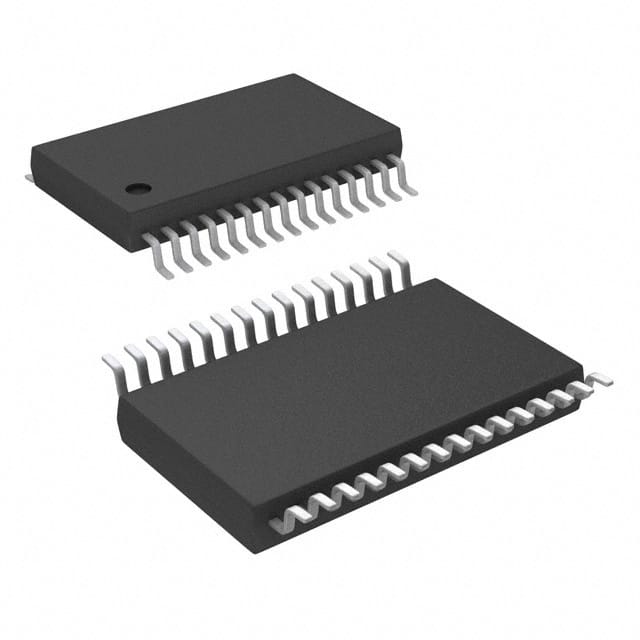Szczegóły produktu można znaleźć w specyfikacjach.

TPS51020DBTG4
Product Overview
Category
The TPS51020DBTG4 belongs to the category of integrated circuits (ICs) and specifically falls under the voltage regulators - switching regulator ICs.
Use
This product is primarily used for power management applications, providing a regulated output voltage from an input voltage source.
Characteristics
- Switching frequency: The TPS51020DBTG4 operates at a high switching frequency, allowing for efficient power conversion.
- Wide input voltage range: It can accept a wide range of input voltages, making it suitable for various applications.
- High efficiency: The switching regulator design ensures high efficiency in converting power.
- Low standby current: The device has a low standby current, minimizing power consumption during idle periods.
Package
The TPS51020DBTG4 comes in a small 30-pin TSSOP (Thin Shrink Small Outline Package) package. This package offers a compact form factor and good thermal performance.
Essence
The essence of the TPS51020DBTG4 lies in its ability to efficiently regulate voltage, enabling reliable power management in diverse electronic systems.
Packaging/Quantity
The TPS51020DBTG4 is typically available in reels or tubes, with a quantity of 2500 units per reel/tube.
Specifications
- Input Voltage Range: 2.5V to 6V
- Output Voltage Range: Adjustable from 0.8V to VIN
- Maximum Output Current: 2A
- Switching Frequency: 500kHz
- Operating Temperature Range: -40°C to +85°C
Detailed Pin Configuration
The TPS51020DBTG4 features a total of 30 pins. Here is a detailed pin configuration:
- EN (Enable)
- FB (Feedback)
- SS/TR (Soft Start/Tracking)
- PGND (Power Ground)
- SW (Switch Node)
- VIN (Input Voltage)
- VBST (Bootstrap Supply)
- AGND (Analog Ground)
- COMP (Compensation)
- SS/TR (Soft Start/Tracking)
- FB (Feedback)
- EN (Enable)
- PGND (Power Ground)
- SW (Switch Node)
- VIN (Input Voltage)
- VBST (Bootstrap Supply)
- AGND (Analog Ground)
- COMP (Compensation)
- SS/TR (Soft Start/Tracking)
- FB (Feedback)
- EN (Enable)
- PGND (Power Ground)
- SW (Switch Node)
- VIN (Input Voltage)
- VBST (Bootstrap Supply)
- AGND (Analog Ground)
- COMP (Compensation)
- SS/TR (Soft Start/Tracking)
- FB (Feedback)
- EN (Enable)
Functional Features
- Wide input voltage range allows for compatibility with various power sources.
- Adjustable output voltage enables flexibility in meeting specific system requirements.
- Soft start and tracking features ensure smooth startup and shutdown sequences.
- Overcurrent protection safeguards the circuit from excessive current flow.
- Thermal shutdown protection prevents damage due to excessive heat.
Advantages and Disadvantages
Advantages
- High efficiency power conversion
- Compact package size
- Wide input voltage range
- Adjustable output voltage
- Low standby current
Disadvantages
- Limited maximum output current (2A)
- Requires external components for operation
Working Principles
The TPS51020DBTG4 operates as a synchronous buck converter, utilizing pulse-width modulation (PWM) techniques to regulate the output voltage. It employs high-frequency switching to efficiently convert the input voltage to the desired output voltage level.
Detailed Application Field Plans
The TPS51020DBTG4 finds applications in various fields, including but not limited to: - Portable electronic devices - Battery-powered systems - Industrial automation - Automotive electronics - Telecommunications equipment
Detailed and Complete Alternative Models
- TPS54320DBVR - Similar voltage regulator IC with a lower maximum output current of 3A.
- LM2576T-ADJ - Non-synchronous buck converter IC with adjustable output voltage and higher maximum output current of 3A.
- LT1763CS8-3.3 - Low dropout linear regulator IC with fixed output voltage of 3.3V and maximum output current of 500mA.
These alternative models offer different features and specifications, providing options for specific application requirements.
Word count: 550 words
Wymień 10 typowych pytań i odpowiedzi związanych z zastosowaniem TPS51020DBTG4 w rozwiązaniach technicznych
Sure! Here are 10 common questions and answers related to the application of TPS51020DBTG4 in technical solutions:
Q: What is TPS51020DBTG4? A: TPS51020DBTG4 is a high-performance, synchronous buck controller designed for various power supply applications.
Q: What is the input voltage range supported by TPS51020DBTG4? A: TPS51020DBTG4 supports an input voltage range from 4.5V to 28V.
Q: What is the output voltage range supported by TPS51020DBTG4? A: TPS51020DBTG4 can generate output voltages as low as 0.8V and as high as the input voltage.
Q: Can TPS51020DBTG4 operate in a wide temperature range? A: Yes, TPS51020DBTG4 is designed to operate in a temperature range from -40°C to 125°C.
Q: What is the maximum output current that TPS51020DBTG4 can handle? A: TPS51020DBTG4 can handle a maximum output current of 2A.
Q: Does TPS51020DBTG4 have any protection features? A: Yes, TPS51020DBTG4 includes overvoltage protection (OVP), undervoltage lockout (UVLO), and thermal shutdown protection.
Q: Can TPS51020DBTG4 be used in battery-powered applications? A: Yes, TPS51020DBTG4 is suitable for battery-powered applications due to its low quiescent current and high efficiency.
Q: Is TPS51020DBTG4 compatible with both ceramic and electrolytic output capacitors? A: Yes, TPS51020DBTG4 is compatible with both ceramic and electrolytic output capacitors.
Q: Can TPS51020DBTG4 be used in automotive applications? A: Yes, TPS51020DBTG4 is AEC-Q100 qualified, making it suitable for automotive applications.
Q: What are the typical applications of TPS51020DBTG4? A: TPS51020DBTG4 is commonly used in point-of-load (POL) converters, telecom equipment, industrial systems, and automotive electronics.
Please note that these answers are general and may vary depending on specific design requirements and application scenarios.

